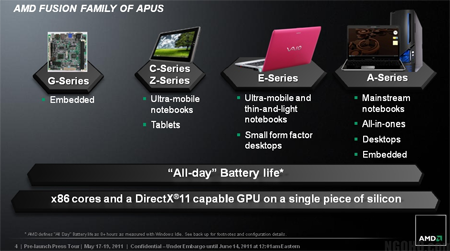Report: AMD plans Z-Series processor for tablets

AMD is working on a new Fusion processor designed specifically for tablets, according to a leaked company presentation. The Z-Series APU (code-named Desna) will use less power, increasing battery life to 10.5 hours, but will still have the processing power to handle HD video and other intensive computing tasks, based on the slides posted on the site Android Community.
The news is not a surprise. Ever since CEO Dirk Meyer left the company after the Consumer Electronics Show in January, there has been speculation that AMD had refocused its strategy on tablets. AMD's first APUs, the C-Series (Ontario) and E-Series (Zacate) weren't meant for tablets, but their low-power design put them within striking distance. In fact, the Acer Iconia Tab W500, a 10.1-inch Windows tablet with a detachable keyboard, already uses the 1.0GHz AMD C-50 dual-core processor.
The slides don't provide many details on the design of the Z-Series, but it is likely to be based on the same low-power Bobcat core used in the current C- and E-Series APUs, perhaps with lower frequencies, more aggressive power management or fewer graphics cores to stretch battery life. It promises to increase rated battery life from 6.5 hours on the 2010 platform to 10.5 hours in this year' s tablet, though it's not clear what AMD means by the 2010 platform since the C-Series did not arrive until earlier this year. The Z-Series is part of the AMD HD Tablet Platform, a name that is meant to emphasize that the APU with DirectX 11 graphics can handle HD video streaming, hardware acceleration (Internet Explorer 9, HTML 5, Adobe Flash 10.2 and Microsoft Office 10), and 3D gaming.
With this tablet platform, AMD is targeting all segments including consumer, small business and verticals such as health care. Based on the slides, it appears that AMD is focusing on Windows 7/Windows 8, particularly for business users, and it isn't clear whether the Z-Series will also work with Android as well (though there have been reports that AMD was looking for Android software engineers).
With the addition of the Z-Series, AMD will have APUs with "discrete-class graphics" covering a broad range of products. In addition to the Z-Series for tablets, C-Series for netbooks and E-Series for ultra-thin laptops, AMD is expected to finally announce its A4 and A6 APUs for mainstream laptops and desktops-including all-in-ones-at the Computex tradeshow in Taiwan this week.
AMD claims more than 145 designs wins for this client platform, which includes features such as AMD Steady Video, which smooths out jerky video; Turbo Core 2.0 for higher performance; and AMD Wireless Display, which is presumably AMD's answer to Intel's wireless display technology. For the high-end, AMD will have the A8, a quad- or six-core CPU (code-named Zambezi) designed to be used with discrete graphics.
Intel has its own tablet platform, known Oak Trail, and the company is expected to show approximately 10 tablets based on the new Atom SoC at Computex. Oak Trail supports Windows, Android (Froyo and Gingerbread now, with Honeycomb in the works), and MeeGo.
